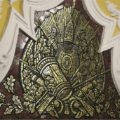Riding the metro every day, we tend not to notice the treasures before our very our eyes. Marble and granite, bronze and crystal, smalti and stained glass — the metro system is decorated with an amazing variety of materials. There’s a reason why many of the Russian metro stations are recognized as monuments of architecture.
The first stations were built like underground palaces — no money was spared for their decor. When Moscow metro was officially opened on May 15, 1935, visitors saw something amazing: large well lit spaces, decorated with marble and incredible works of art that could be the envy of many museums around the world. In order to tell about all the techniques and technologies used in the decoration of the Russian metro, you would need an encyclopedia. Let’s dwell on the most iconic and memorable decors.
Smalti Mosaic
Its model is the Komsomolskaya-Koltsevaya metro station. It was conceived as a front entry, because those arriving to three Moscow train stations descended the metro right here. The design of the station was entrusted to the talented artist Pavel Korin. On the vault of the platform hall there are large panels with the theme of Victory, depicting war trophies from different historical periods. The golden smalti make mosaic very bright. Smalti is an opaque colored glass treated with oxides of various metals. This material does not fade nor deteriorate over time.
Pavel Korin also created the smalti mosaic at the end of the Novoslobodskaya station hall: a woman with a child reaching out to the sun and the famous inscription World Peace.
A rich gallery of the Kievskaya metro station was made of smalti mosaic as well. The panels are framed with gilded moldings and look like museum paintings in frames.
The largest panel of smalti mosaic (21 meters in length) of the St. Petersburg metro is located at the Zvenigorodskaya station. Its arstists are Alexander and Yegor Bystrov. Father and son also worked on smalti mosaics that adorn the walls of the Admiralteyskaya metro station.
There are two types of luxurious mosaic that decorate modern Bucharest metro station in St. Petersburg, opened in 2012. Autumn smalti mosaic in the South end of the Station, and in the lobby there is a mosaic made of color marble in Florentine technique.
Florentine Mosaic
Another type of mosaic is made of colored minerals. Those visiting the Chekhovskaya station in Moscow could have seen it for sure. It is worth waiting for the train to leave and real works of art appear on the walls opposite the platform. Panels made of 17 types of colored minerals — from lapis lazuli to jasper — were created by artists Peter and Lyudmila Shorchevs. Each image consists of stone pieces of different shapes tightly fit together with each other — so that the joints between them are almost invisible and can be determined only by the difference in color. The artists use only the natural color and pattern of the stone to create their mosaics.
Panels in the technique of Florentine mosaic decorate the vaults of the Belorusskaya-Koltsevaya metro. The most interesting thing at the station is the ceiling. Raising your head, you can see 12 mosaic panels depicting scenes of the life of Belarusian peasants. All images are made of natural stone.
In St. Petersburg, you can enjoy mosaic made in the old technique of Italian masters at the Baltiyskaya metro station. Almost the entire end wall is decorated with the Florentine mosaic called 1917. Florentine mosaics of both Baltiyskaya and Narvskaya stations have been made by Georgy Rublev and his son Igor Rublev. The artists recalled that in order to find stones of the desired shade in a pile of marble, they had to spend almost the entire summer in the workshops of the Moscow Marble Factory.
The creators of the Sibirskaya station in Novosibirsk managed to express the strength and character of their land. Eight wall Florentine mosaics tell us about the riches and the beauty of local nature. In Nizhny Novgorod, a mosaic of colored minerals adorns the ticket lobby of the Moskovskaya metro station. The panel depicts the past and the present of the Russian capital.
Mosaic Stained Glass
The standard for metro stained glass decor is considered to be the Novoslobodskaya station in Moscow. 32 compositions of colored glass make it truly fabulous. The stained glass windows were made in Riga of the same material that was used to decorate Catholic cathedrals.
Mosaics of the Trubnaya station look so traditional that it seems as if they were made several decades ago. It is difficult to say what they are exactly: mosaics or stained glass. On the one hand, the panels are made of separate glass tesserae like mosaic, on the other, they are transparent, backlit and look like windows. Zurab Tsereteli, the author of the stained-glass windows, depicted the ancient cities of Russia on them. One can recognize each of them by the characteristic architecture and their names “built-in” into compositions.
In St. Petersburg, one can enjoy the mosaic stained-glass windows at the Parnas metro station. Their peculiarity is the combined techniques — in part glass is colored in part painted.
Majolica
The Baumanskaya metro station in Moscow is famous for the Glory of the Soviet Army majolica. It is composed of small ceramic tiles with colored glazes. Fair in Zamoskvorechye majolica in the Gzhel style adorns the southern lobby of the VDNKh metro station. It is not an easy task to create a panel from individual elements in this technique. This was especially true for the academician of art Evgeny Lanser, the designer of the Komsomolskaya station. In an unusual and vivid material, he artistically depicted all stages of the construction of the metro — from working in the mine to finishing the station.
Bas-reliefs and high-reliefs
More than 60 bas-reliefs and plaster medallions can be counted on the pylons of the Dynamo metro station in Moscow. Football, discus throw, tennis, weightlifting, hockey, gymnastics and other sports are reflected in the works of the sculptor Elena Yanson-Manizer. It is believed that real athletes served as prototypes for some medallions.
Based on the sketches of the artist Georgy Motovilov, famous bas-reliefs were created at the Elektrozavodskaya metro station in Moscow. They depict the labor of Soviet people: machine builders, blacksmiths, agriculture and, of course, electric plant workers.
The bas-reliefs of Elektrozavodskaya have been transformed into high reliefs at Narvskaya station in St. Petersburg. The peculiarity of the sculptures here is in their volume. The figures seem to emerge from the wall, decorating the perspectives of the central hall. The main theme here is the same — the glory of the Soviet people labor. The reliefs are made of plaster, although originally they were planned to be made of marble.
Embossed Copper Decor
Relief design in metal sheets are the basis for the decor of the Pushkinskaya metro station in Moscow. 8 embossed copper panels, 4 on each side of the hall, immortalize places from the life of the great Russian poet Pushkin and lines from his poems. The white marble background of the walls contrasts with the metal reliefs and the lines of the poems made in the reddish-orange tones, conveying the overall lyrical mood.
Light Boxes
A new trend is to decorate metro vaults with light boxes, as, for example, at the Novoperedelkino station in Moscow. The lighting in them changes from neon to pastel shades, creating whimsical patterns.
The Botanicheskaya metro station in Yekaterinburg is also remembered for its originality. Its ceiling is made of honeycomb shaped lamps. They create soft, warm light which is reflected in the metal-clad columns. This and other design findings were brought to life by local authors — Yekaterinburg artists, designers and architects.
Glass Paintings
The Bitsevsky Park station in Moscow is so far the only one decorated with triplex — tempered glass sheets laminated and held together with a special polymer film. If you paint the film in the middle, you get a picture “sealed” in the glass. A panel, depicting the life of the Bitsa equestrian sports complex, has been assembled from 359 such puzzles .
Over the years, Russian metro stations have become a real treasure trove of decor ideas from different periods. What becomes of metro in the future — time only tells. Nevertheless then, and now, going underground, it is worth looking around more carefully: works of art are sometimes closer than they seem.
Elena Malinovskaya








